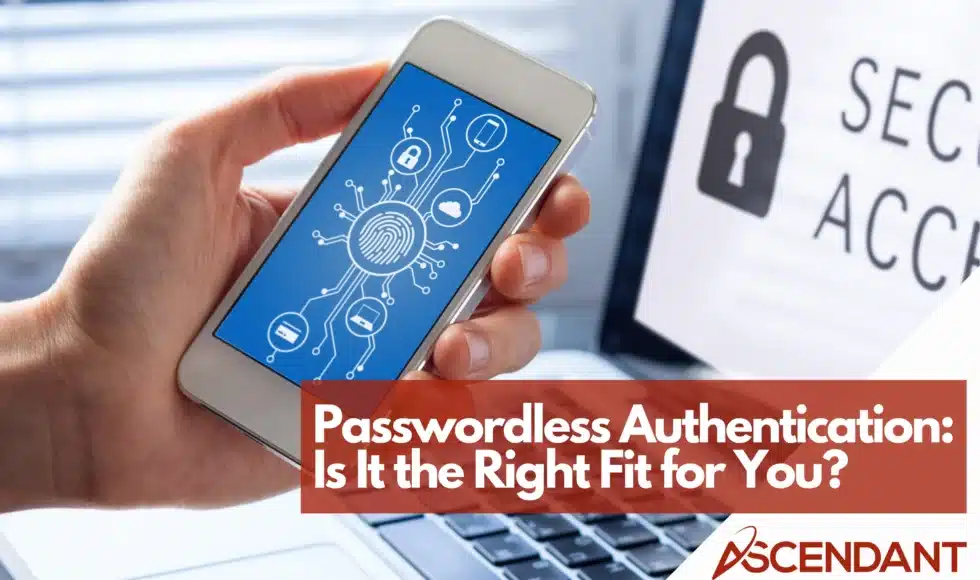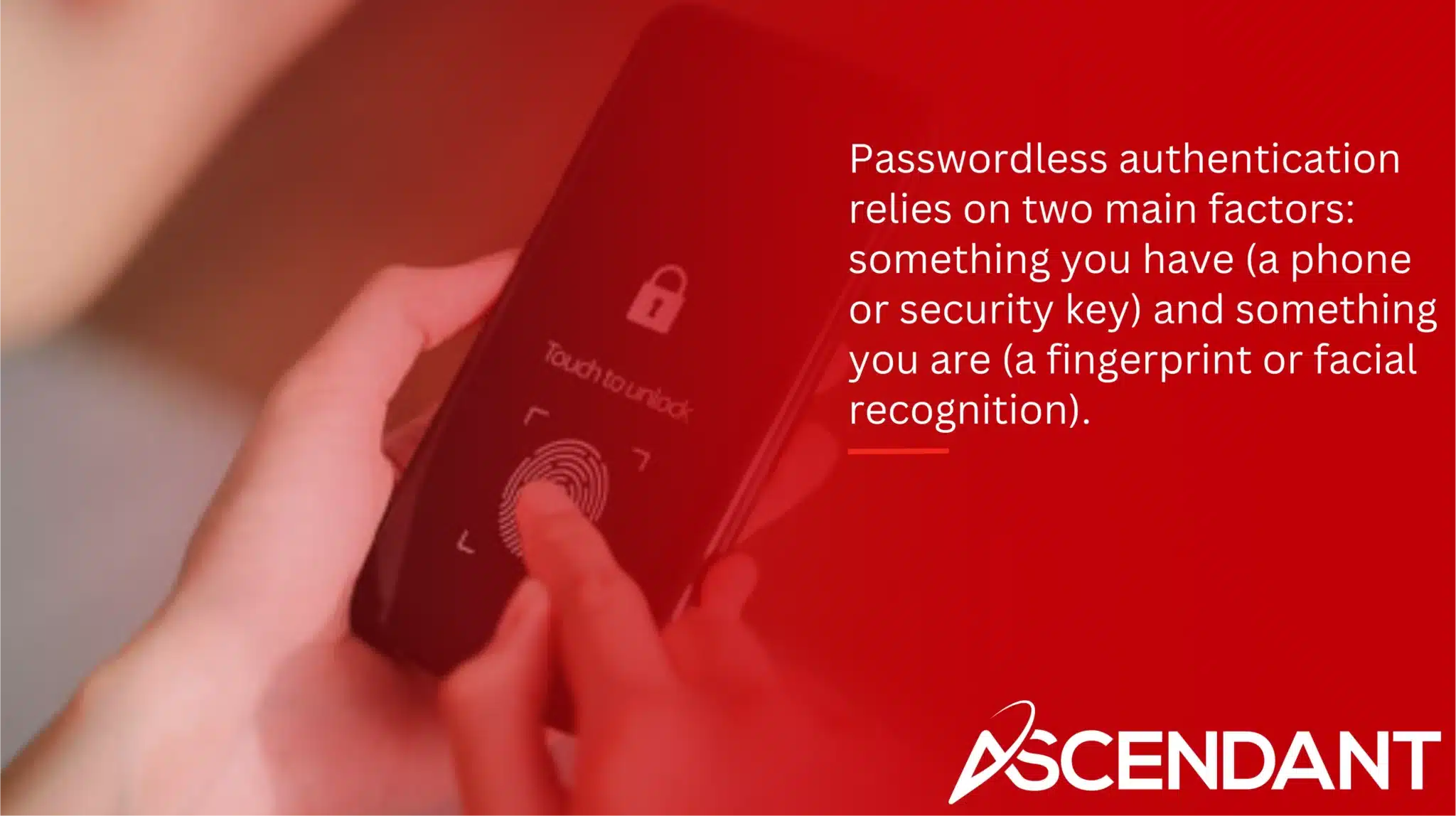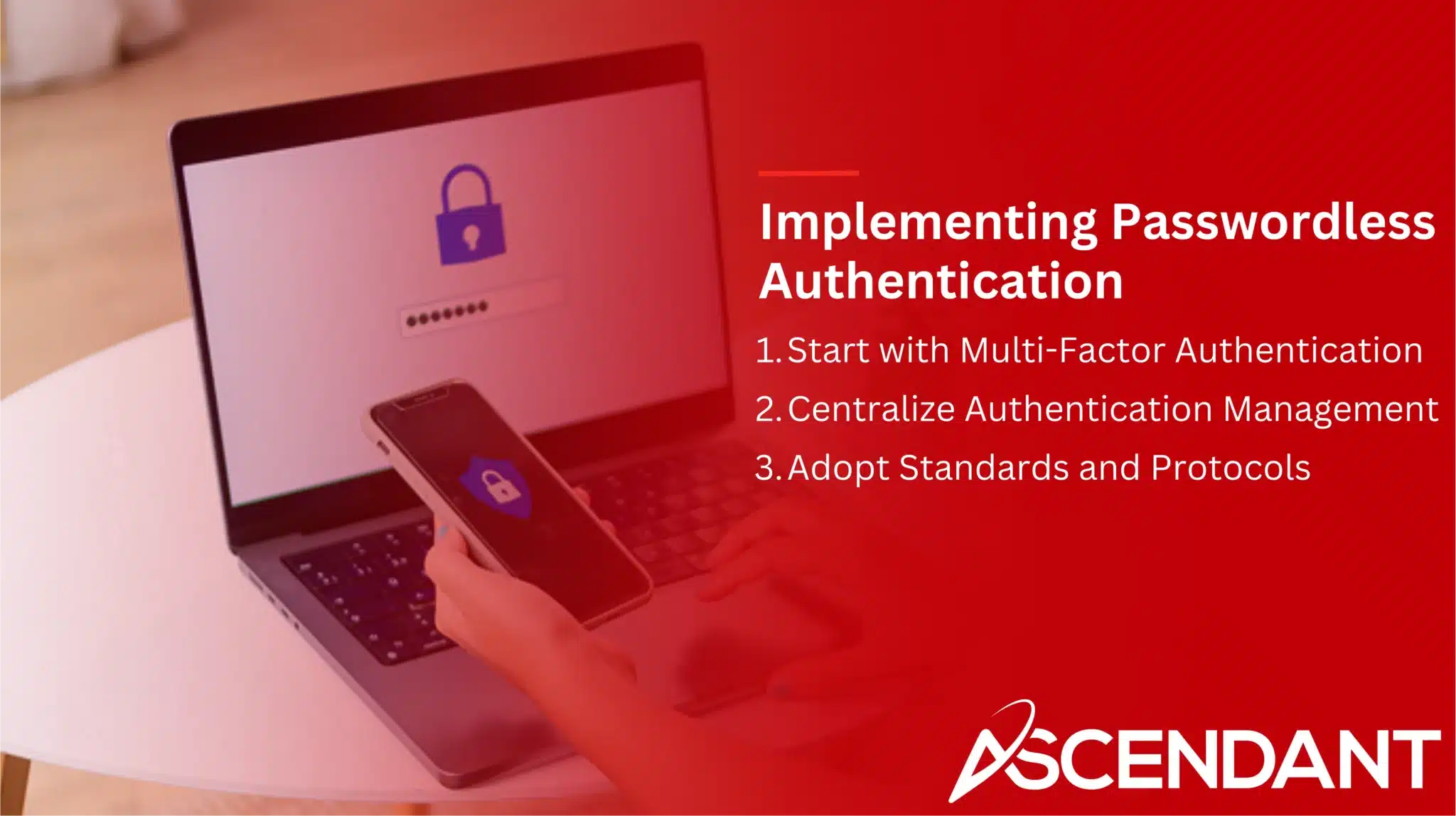Passwordless authentication uses biometrics or hardware tokens instead of passwords. It offers better security and an easier user experience. This article explains what passwordless authentication is, how it works, and its benefits.
Key Takeaways
- Passwordless authentication increases security by eliminating traditional password vulnerabilities and utilizing biometric data and hardware tokens.
- Implementing passwordless authentication improves user experience by simplifying the login process, reducing password management frustrations, and enhancing customer satisfaction.
- The adoption of passwordless authentication is rapidly growing across industries, driven by the demand for secure and user-friendly solutions, with significant growth expected in the coming years.
Understanding Passwordless Authentication
The authentication method of going passwordless does away with the conventional reliance on passwords, opting for alternative means such as biometrics or hardware tokens. The trajectory of information security is heading towards an era where usernames and passwords become obsolete. Innovative technologies are facilitating this transition by bolstering security at access points and fostering a strong ecosystem devoid of passwords.
Shifting to passwordless authentication across organizations presents obstacles, necessitating a departure from established protocols involving traditional passwords towards novel security strategies. Such changes come with significant advantages, presenting an authentication method that not only enhances overall security but also improves user experience.
The Shortcomings of Traditional Passwords
Authentication methods based on standard passwords are fraught with critical security gaps that attract the attention of cyber attackers. Techniques such as phishing, brute-force attacks, and credential theft leverage these flaws to acquire unauthorized access, consequently leading to data breaches involving compromised credentials. The complexity required for secure passwords often results in user difficulty remembering them, causing a cycle of resets and added frustration which escalates security vulnerabilities.
The cumulative effect of these weaknesses and difficulties associated with password management not only heightens risks but also imposes significant financial burdens on organizations due to potential reputational harm following a data breach along with operational expenditures related to frequent password management issues. This reality emphasizes an urgent call for more sophisticated yet accessible authentication alternatives that enhance security while improving user experience.
How Passwordless Authentication Works
Passwordless authentication relies on two main factors: something you have (a phone or security key) and something you are (a fingerprint or facial recognition). Biometric methods like fingerprints, face scans, and voiceprints are popular for their convenience and security. Notifications may prompt users to confirm or authorize actions on trusted devices, simplifying the process.
Methods like magic links, biometric recognition, security keys such as YubiKey, and authenticator apps are common in passwordless authentication. For example, a user might provide their email address and receive a magic link for quick access. Public-key cryptography often ensures that private keys remain secure on user devices.
The process captures biological and behavioral traits, converts them into numerical data, and compares them to stored information in the authentication process. This simplifies login and boosts security by eliminating weak passwords. One-time passwords (OTPs) sent to users’ contact channels add another layer of security.
Is Passwordless Authentication Safe?
The method of passwordless authentication is widely considered more secure than conventional passwords, offering robust defense against typical cyber threats. This approach effectively counters risks stemming from weak passwords, phishing schemes, and the theft of credentials. By not requiring a user to transmit a password to the website, this system renders passkeys impervious to phishing efforts.
Incorporating biometric factors into multi-factor authentication frameworks targets the principal source of security breaches: compromised login details. Utilizing risk-based multi factor authentication involves scrutinizing both context and behavior during access attempts, thereby fortifying security with additional verification layers through multiple authenticating elements.
By drastically diminishing the threat posed by social engineering and phishing endeavors, passwordless systems present themselves as safer options in contrast to their traditional passphrase-dependent counterparts. For heightened security measures within organizations, adopting methods of passwordless authentication is advisable.
Key Benefits of Passwordless Authentication
Eliminating conventional passwords through passwordless authentication provides numerous advantages, such as heightened security, better user experience, and lowered information technology expenses. It fits seamlessly with the Zero Trust security model by consistently authenticating users at every entry point, thereby diminishing the dependency on passwords and decreasing both prompts for them and their overall exposure.
This approach streamlines both sign-up and sign-in procedures, which elevates user contentment while also leading to substantial reductions in helpdesk expenditures because of a drop in necessary password resets. Organizations seeking to improve security protocols and enrich the end-user experience without escalating costs find passwordless authentication an appealing solution.
Enhanced Security
Passwordless authentication aims to minimize risk exposure and improve security measures. It solidifies trust in the safety of online transactions by verifying user identity with a high degree of confidence. When multi-factor authentication is employed, it presents additional barriers to unwelcome access, thereby bolstering overall protection.
The implementation of passwordless systems decreases vulnerabilities linked to passwords, curtailing the likelihood of security infringements. This approach is particularly vital given the growing complexity and relentless nature of modern cyber-attacks.
Improved User Experience
Transitioning to passwordless authentication eliminates the inconveniences associated with generating, recalling, and resetting forgotten passwords. This change elevates user productivity by diminishing irritation and streamlining their login experience.
Within the retail sector, eliminating passwords can decrease instances of shopping cart abandonment by making checkout procedures more straightforward. Such an effortless process increases customer contentment, fosters brand loyalty, and promotes recurring purchases—all contributing positively to the user experience.
Reduced IT Costs
The economic impact on organizations due to password management, encompassing resets, security breaches, and associated IT support, is substantial. A significant fraction of the expenses incurred by help desks arise from maintaining passwords and managing issues related to their reset. Transitioning towards a system that eliminates the use of passwords can lead to a marked decrease in expenditures for managing password policies and handling support tickets that stem from resetting passwords.
In essence, shifting away from traditional password-based systems enhances an organization’s operational efficiency while simultaneously decreasing IT support costs. It also minimizes the volume of inquiries directed at help centers concerning password issues.
Popular Passwordless Authentication Methods
Utilizing methods such as biometric verification or security keys, passwordless authentication offers a higher level of protection by circumventing vulnerabilities associated with passwords, thus significantly reducing risks like phishing attacks and credential theft. Industry leaders such as Apple, Google, and Microsoft have propelled this advancement by introducing FIDO2 passkeys to the forefront of technological development.
As novel options including magic links and passkeys rise in popularity due to their improved user interfaces and heightened security measures, they are increasingly becoming favored alternatives among entities pursuing the adoption of passwordless systems. These approaches furnish users with secure yet user-friendly ways to authenticate themselves without relying on traditional passwords.
Biometric Authentication
Authentication methods that utilize biometrics, such as facial recognition and fingerprint scanning, confirm users’ identities by analyzing unique biological characteristics. New techniques including heart signatures and retinal scans are being developed to provide even more secure identity confirmation layers.
Users have the ability to manage their own personal data since this biometric information is kept on their devices, which lessens the chance of credentials being stolen. Due to its ease of use and enhanced security features, biometric authentication has become a popular option for passwordless access.
Security Keys and Tokens
YubiKeys and similar security keys offer a solid alternative to password-based logins, enabling swift access to various services through the mere action of pressing a button or entering information on a keypad. These devices come in USB, Bluetooth, or NFC formats and elevate login procedures by eliminating the need for conventional usernames and passwords while bolstering overall security.
The approach of passwordless authentication is grounded in asymmetric cryptography involving pairs of public and private keys. It utilizes the private key to authenticate challenges posed by servers, which confirms secure interactions and safeguards against any potential unauthorized entry.
Push Notifications and One-Time Passwords (OTPs)
During the login process, push notifications swiftly confirm the user’s identity, enabling prompt authorization or rejection of entry. To log in, users must input one-time passwords (OTPs) that are dispatched to their phone or email.
These OTPs bolster security by guaranteeing that unauthorized individuals cannot obtain access if a device falls into the wrong hands without possessing this exclusive and time-limited code. These strategies provide secure and convenient alternatives for authentication without needing a password.
Implementing Passwordless Authentication
To minimize disruption and guarantee a seamless transition, adopting passwordless authentication ought to be executed in stages. It’s vital for organizations to adopt an authentication strategy that fits the requirements of both users and their applications. During this transitional period, establishing access policies that bolster identity verification and security enhancement is imperative.
Crucial components for realizing a passwordless environment encompass robust multi-factor authentication (MFA), single sign-on (SSO) solutions, adaptive access strategies, as well as capabilities for device trustworthiness. Overcoming technical hurdles associated with intricate hybrid environments is fundamental to effectuate successful deployment.
Start with Multi-Factor Authentication (MFA)
The cornerstone of a strategy aimed at eliminating the need for passwords is Multi-Factor Authentication (MFA). This approach assesses each login attempt’s risk by considering its security context and accordingly selects an apt multifactor authentication method. In scenarios where the necessary extra verification through risk-based MFA isn’t provided, access is consequently restricted.
Implementing MFA as an initial step sets up a robust foundation in terms of security, which facilitates a more seamless and secure shift towards passwordless authentication systems.
Centralize Authentication Management
Streamlining user authentication management is key to the successful adoption of passwordless systems, and Microsoft Entra ID excels in this by handling a range of options such as Windows Hello for Business, the Microsoft Authenticator app, and FIDO2 security keys. Duo also complements these efforts either by integrating with current SSO platforms or presenting its own single sign-on solutions for applications that use SAML.
The deployment of these technologies enables companies to provide secure access through methods other than conventional passwords while simultaneously bolstering the overall user experience. By centralizing control over user authentication, organizations not only enhance their security posture, but also simplify procedures related to accessing systems.
Adopt Standards and Protocols
Incorporating protocols such as FIDO2 and methods like certificate-based authentication can considerably elevate both the safety and user experience within environments that forgo passwords. Security is bolstered through the use of public key cryptography via FIDO protocols, offering a strong defense against numerous online threats.
Eliminating password usage mitigates potential security issues tied to passwords, aiding in adherence to legislative measures such as GDPR and CCPA. Through standards like WebAuthn, seamless integration with various systems for passwordless authentication becomes possible, which also complements certificate-based strategies.
Use Cases for Passwordless Authentication
Sectors like healthcare, retail, and financial services are at the forefront in embracing passwordless authentication technologies. They acknowledge that such methods not only bolster security but also elevate the user experience, which makes them particularly well-suited for these industries.
In the near future, it is anticipated that companies within both retail and financial industries will increasingly adopt passwordless authentication systems. Numerous firms have already laid out plans to integrate these solutions into their operations.
Financial Services
Financial institutions are improving security protocols and customer experiences by implementing passwordless authentication systems. These solutions facilitate secure access to confidential information, minimizing the chances of unauthorized entry and potential data breaches.
Driven by the demand for strong security alongside efficient user interactions, financial sector entities are embracing passwordless authentication methods. This not only safeguards vital financial records, but also enhances client confidence and contentment.
Healthcare Sector
Within the healthcare industry, eliminating password-based authentication mitigates the threat of illicit entry to confidential patient data. By protecting such information and facilitating secure access for medical documentation, healthcare practitioners can improve both the security and productivity of their systems.
These passwordless mechanisms simplify patients’ ability to obtain their medical records, resulting in a more streamlined and intuitive experience. This is becoming increasingly vital within a sector where prompt and secure access to pertinent data can greatly affect the quality of care provided to patients.
Retail and eCommerce
Top e-commerce platforms such as Amazon and eBay are adopting passwordless authentication methods to bolster user security while making the login procedure more straightforward. Employing techniques like biometric scans and passkeys enables these businesses to drastically decrease the likelihood of account takeovers as well as data breaches.
The transition towards passwordless systems may elevate customer satisfaction by eliminating common aggravations that stem from forgotten passwords and mistakes during login. Offering a smooth login experience through these innovative solutions has the potential to amplify conversion rates, prompting customers to follow through with their purchases.
Future Trends in Passwordless Authentication
The market for passwordless authentication methods is on the rise and projected to attain a value of around $60.34 billion by 2032, expanding at a compound annual growth rate (CAGR) of about 15.7%. This surge can be attributed to the escalating demand for authentication methods that are both secure and improve user experience.
With their capacity to produce exclusive identifiers or single-use codes, hardware tokens are becoming an increasingly preferred option in secure authentication techniques. As technological advancements continue, it’s anticipated that we will witness even more breakthroughs within the realm of passwordless authentication, aiming to bolster security while simultaneously elevating the user experience throughout multiple sectors.
 Summary
Summary
The adoption of passwordless authentication marks a significant advancement in the realm of digital access security. By moving away from traditional passwords, which are often susceptible to compromise, this method offers heightened security along with an improved user experience and potential reductions in IT-related expenses. Utilizing various approaches such as biometric verification, secure keys, and push alerts provides strong substitutes for conventional password systems.
A calculated approach is necessary when implementing passwordless authentication – it typically begins with establishing multi-factor authentication (MFA) and consolidating the management of these authentications. Compliance is assured by aligning with standards like FIDO2 that also serve to bolster overall protection measures.
With sectors including finance, healthcare, and retail at the forefront of adopting these methods, the outlook on adopting passwordless strategies seems optimistic indeed. As organizations integrate this technology into their frameworks, they edge closer to a landscape marked by greater security efficiency within the digital domain.
Frequently Asked Questions
What is passwordless authentication?
By eliminating conventional passwords and adopting alternative verification methods like biometrics or hardware tokens, passwordless authentication significantly bolsters security. This strategy not only augments the user experience but also diminishes the likelihood of breaches associated with passwords.
How does passwordless authentication work?
Passwordless authentication operates primarily through two factors: something you possess, such as a phone or security key, and biometric identification, such as a fingerprint. This enhances security and user convenience by utilizing methods like biometric recognition, security keys, and magic links.
Is passwordless authentication safe?
Passwordless authentication is indeed safer than traditional passwords, as it significantly reduces the risks of credential theft and phishing attacks.
Adopting this method can enhance overall security for users.
What are the benefits of passwordless authentication?
Passwordless authentication enhances security, improves user experience, and reduces IT costs.
These advantages make it a compelling choice for organizations looking to streamline access while safeguarding sensitive information.
Which industries are adopting passwordless authentication?
Financial services, healthcare, and retail are primarily adopting passwordless authentication, indicating a significant shift towards enhanced security measures in these sectors.



